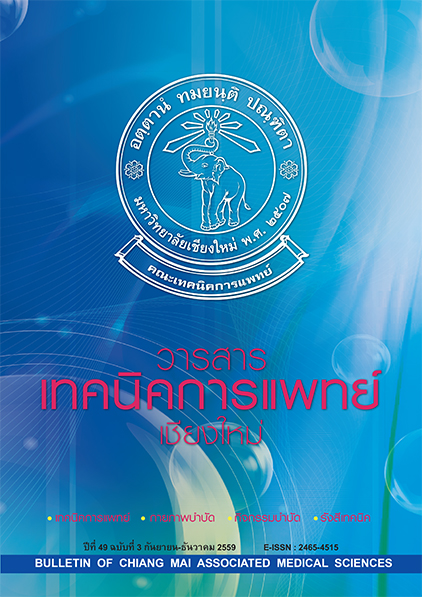Effects of region of interest to noise measurement in computed tomographic image
Main Article Content
Abstract
Background: In digital medical image, there are several factors affecting image quality such as image noise, spatial resolution, sharpness and contrast. Image noise of computed tomographic (CT) image can be quantified from the standard deviation (SD) of CT number in region of interest (ROI) of the image of a uniformity object. Therefore, the determination of ROI might be affected to noise measurement.
Objectives: The purpose of this study is to evaluate the effects of ROI determination by varying size, location and number of ROIs to noise measurement in CT images.
Materials and methods: CTDI phantom (32 cm diameter) was scanned using 120 kVp 180 mAs. The slice thickness were 1, 2, 3, and 5 millimeters. ROIs were placed at 40, 80, and 120 mm from the center of field of view (FOV) using 125, 250, 500, 1,000, and 2,000 mm2 with 1, 2, 4, 6, and 8 points each.
Results: It was shown that size and numbers of ROIs did not significantly (p<0.05) effect to image noise while the distance from the center of FOV and slice thickness significantly impact to the image noise (p>0.05).
Bull Chiang Mai Assoc Med Sci 2016; 49(2): 312-322. Doi: 10.14456/jams.2016.37
Article Details
Personal views expressed by the contributors in their articles are not necessarily those of the Journal of Associated Medical Sciences, Faculty of Associated Medical Sciences, Chiang Mai University.
References
2. Carrino JA. Digital image quality: A clinical perspective. Quality assurance The Society for Computer Applications in Radiology, Great Falls, VA. 2003: 29-37.
3. Bongartz G, Golding SJ, Jurik AG, Leonardi M, Meerten EvPv, Geleijns J, et al. General principles associated with good imaging technique: Technical, clinical and physical parameters. EUR 16262 EN.
4. Goldman LW. Principles of CT: Radiation Dose and Image Quality. J Nucl Med Technol. 2007; 35(4): 213-25.
5. Seeram E. Computed Tomography: Physical Principles, Clinical Applications, and Quality Control. 3rd ed. St. Louis, Mo.: Saunders/Elsevier; 2009.
6. McNitt-Gray MF. Tradeoffs in CT Image Quality and Dose 2003 [cited 2016 2/8]. Available from: https://www.aapm.org/meetings/03AM/pdf/9794-13379.pdf.
7. General Principles Associated with Good Imaging Technique: Technical, Clinical and Physical Parameters [cited 2014 28 December]. Available from: http://www.drs.dk/guidelines/ct/quality/Page004.htm.
8. Edyvean S. Effect of ROI Size on Image Noise [PDF]. 2003 [cited 2016 21 January ]. Available from: http://www.ctug.org.uk/meet04-01-13/roi_size_image_noise.pdf.
9. Radiology ACo. CT Accreditation Phantom Instructions [cited 2016 20 January]. Available from: http://www.acr.org/~/media/ACR/Documents/Accreditation/CT/PhantomTestingInstruction.pdf.
10. Dolly S, Chen H, Anastasio M, Mutic S, Li H, editors. Evaluations of the Noise Power Spectrum of a CT Iterative Reconstruction Technique for Radiation Therapy. AAPM 2014 Innovation: 56th Annual Meeting & Exhibition; 2014 20-24 July 2014; Austin, Texas, USA.
11. Joseph N, Rose T. Quality Assurance and the Helical (Spiral) Scanner [cited 2014 28 December ]. Available from: https://www.ceessentials.net/article33.html.
12. Namasivayam S, Kalra MK, Pottala KM, Waldrop SM, Hudgins PA. Optimization of Z-Axis Automatic Exposure Control for Multidetector Row CT Evaluation of Neck and Comparison with Fixed Tube Current Technique for Image Quality and Radiation Dose. Am J Neuroradiol 2006; 27(10): 2221-5.
13. Patino M, Fuentes JM, Hayano K, Kambadakone AR, Uyeda JW, Sahani DV. A quantitative comparison of noise reduction across five commercial (hybrid and model-based) iterative reconstruction techniques: an anthropomorphic phantom study. Am J Roentgenol 2015; 204(2): W176-83.
14. Barrett JF, Keat N. Artifacts in CT: Recognition and Avoidance. Radiographics 2004; 24(6): 1679-91.
15. Boas FE, Fleischmann D. CT artifacts: causes and reduction techniques. Imaging Med 2012; 4(2): 229-40.


